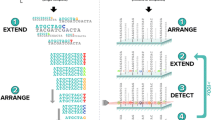Abstract
We report on a unified rapid betaine-based-PCR protocol for amplification of the (CAG)n region in Huntington disease (HD) and the (CGG)n region in Fragile X syndrome (FXS), followed by an electrophoretic separation on automated sequencer for precise determination of the triplet numbers. The high betaine concentration (2.5 M betaine) permits precise amplification of the CAG and CGG repeats. Ten HD affected patients and 10 healthy individuals from HD families were re-evaluated. For FXS the CGG region in normal individuals and premutations of about 100 repeats were precisely amplified by this protocol. Ten unrelated FXS premutation carriers and 24 mentally retarded non-FXS affected boys were re-examined by this method. The results totally coincided with the previous ones. This protocol is a good choice as a fast screening test. Within 24 h we can have preliminary information on the patient’s genetic status. Normal individuals, CGG premutation carriers up to 100 repeats, as well as HD patients carrying an expansion up to 50 CAG repeats can be easily clarified. This accounts for a relatively large proportion (about 90%) of the suspected HD and FXS patients, referred to our laboratory for genetic analysis. The calculation of the repeat’s number is more accurate for the correct interpretation of the results, screening tests and genetic counselling.


Similar content being viewed by others
References
Huntington’s Disease Collaborative Research Group. (1993). A novel gene containing a trinucleotide repeat that is expanded and unstable on Huntington’s disease chromosomes. Cell, 72, 971–987.
Rubinsztein, D. C., Leggo, J., Coles, R., Almqvist, E., Biancalana, V., Cassiman, J.-J., et al. (1996). Phenotypic characterization of individuals with 30–40 CAG repeats in the Huntington disease gene (HD) reveals HD cases with 36 repeats and apparently normal elderly individuals with 36–39 repeats. American Journal of Human Genetics, 59(1), 16–22.
Brinkman, R. R., Mezei, M. M., Theilmann, J., Almqvist, E., & Hayden, M. R. (1997). The likelihood of being affected with Huntington disease by a particular age for a specific CAG size. American Journal of Human Genetics, 60, 1202–1210.
Fu, Y. H., Kuhl, D. P., Pizzuti, A., Pieretti, M., Sutcliffe, J. S., Richards, S., et al. (1991). Variation of the CGG repeat at the fragile X site results in genetic instability: resolution of the Sherman paradox. Cell, 67, 1047–1058.
Jin, P., & Warren, S. T. (2000). Understanding the molecular basis of fragile X syndrome. Human Molecular Genetics, 9, 901–908.
Warmer, J. P., Barron, L. H., Goudie, D., Kelly, K., Dow, D., Fitzpatrick, D. R., et al. (1996). A general method for the detection of large CAG repeat expansion by fluorescent PCR. Journal of Medical Genetics, 33, 1022–1026.
Tassone, F., Pan, R., Amiri, K., Taylor, A. K., & Hagerman, P. J. (2008). A rapid polymerase chain reaction-based screening method for identification of all expanded alleles of the fragile X (FMR1) gene in newborn and high-risk populations. Journal of Molecular Diagnosis, 10, 43–49.
Blanco, S., Suarez, A., Gandia-Pla, S., Gomez-Llorente, C., Antunez, A., Gomez-Capilla, J. A., et al. (2008). Use of capillary electrophoresis for accurate determination of CAG repeats causing Huntington disease. An oligonucleotide design avoiding shadow bands. Scandinavian Journal of Clinical and Laboratory Investigation, 68(7), 577–584.
Riess, O., Noerremoelle, A., Soerensen, S. A., & Epplen, J. T. (1993). Improved PCR conditions for the stretch of (CAG)n repeats causing Huntington’s disease. Human Molecular Genetics, 2(6), 637.
Todorov, T., Todorova, A., Kirov, A., Dimitrov, B., Carvalho, R., Nygren, A. O. H., Boneva, I., & Mitev, V. (2009). Fragile X mosaic male full mutation/normal allele detected by PCR/MS-MLPA. BMJ Case Reports. doi:10.1136/bcr.06.2008.0139.
Acknowledgments
The fellowship from Alexander von Humboldt Foundation to Dr. Albena Todorova is gratefully acknowledged. The study was supported by the Grants No 23/2008 and No 32/2009, Medical University Sofia, Bulgaria.
Author information
Authors and Affiliations
Corresponding author
Additional information
Tihomir Todorov and Albena Todorova contributed equally to the present study.
Rights and permissions
About this article
Cite this article
Todorov, T., Todorova, A., Georgieva, B. et al. A Unified Rapid PCR Method for Detection of Normal and Expanded Trinucleotide Alleles of CAG Repeats in Huntington Chorea and CGG Repeats in Fragile X Syndrome. Mol Biotechnol 45, 150–154 (2010). https://doi.org/10.1007/s12033-010-9260-y
Published:
Issue Date:
DOI: https://doi.org/10.1007/s12033-010-9260-y




